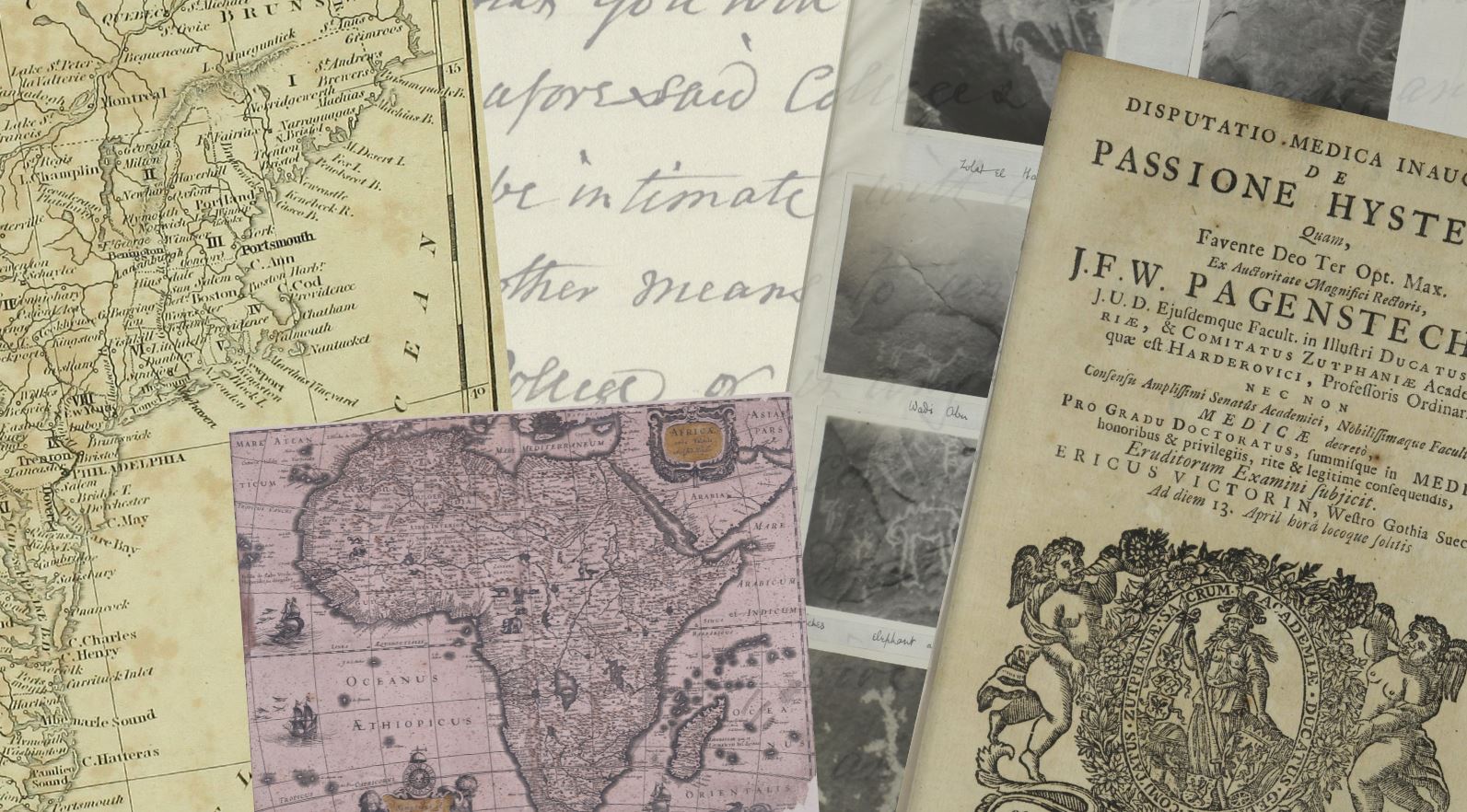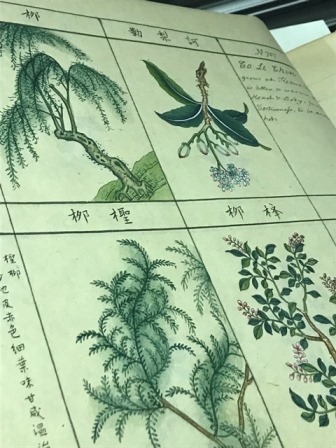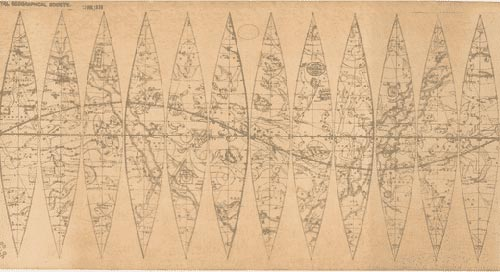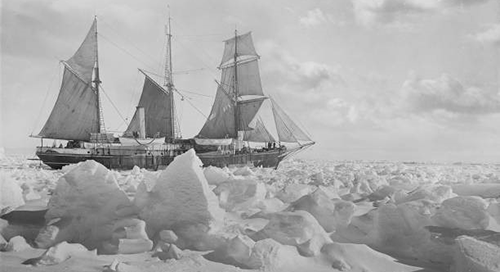Cheers to Five Centuries of Discovery in the year 23
December 13, 2022
We’re ready to ring in 2023 by looking back at what scientists were discovering during this time 100, 200, 300, 400 and 500 years ago. Here’s to how far we’ve come and how far we will continue to go!
Join us as we time travel five centuries through the archives of the Royal College of Physicians and the Royal Geographical Society with IBG, available on Wiley Digital Archives, to see what was happening in the year '23:

Only five years after the end of World War I, 1923 was a time of great global change including colonialism, the fight for women’s rights, and huge medical discoveries including the use of insulin to treat diabetes. Here is a little glimpse of 1923 in Wiley Digital Archives:
A 1923 map of the Union of South Africa depicts the joining of the Cape, Natal, Transvaal, and Orange River colonies that took place in 1910. The Union was established as part of the British Dominion and the official languages of the union were English, Dutch, and Afrikaans (a language derived from Dutch and localized in the Dutch Cape Colony). After becoming a republic, the union dissolved in 1961.
Source: Royal Geographical Society with IBG
During the Summer of 1923, Douglas Newbold wrote about a round-trip expedition through the Libyan desert, from Bara to Bir Natrun, consisting of one thousand and seventy miles. Newbold stated that a large part of the trek consisted of journeying through “desert previously untraversed by a white man.” The piece is titled “A desert odyssey of a thousand miles.”
Source: Royal Geographical Society with IBG
The introduction of canned food preservation, starting in the 18th and 19th centuries, introduced a new host of questions surrounding health concerns. William George Savage published a book in 1923 that examined the relationship between canned food and health, posing the question, “Is this drastic change one to be encouraged wholeheartedly or is it, like so many modern contrivances, fraught with its own menace and disadvantages which have to be eliminated or at least guarded against, before its benefits can be reaped?”
Source: Royal College of Physicians
In “The Wisdom of the Body,” written in 1923, British physiologist Ernest Henry Starling highlights medical discoveries by William Harvey, who was known for discoveries addressing blood circulation. Starling makes mention of notable breakthroughs in cardiology and references influential cardiologists of the time.
Source: Royal College of Physicians

European colonization in the U.S. came grinding to a halt in 1823 with the introduction of the Monroe Doctrine. This time started to promise new settlement opportunities in the United States, though a civil war was preparing to start 38 years later that would result in the abolishment of slavery. Expeditions heavily concentrated on finding the Northwest passage and reaching the polar regions. Read up on breakthroughs in 1823:
In 1823, British sailor and navigator James Weddell sailed for Antarctica. While he may not have reached the continent during his expedition, Weddell reached the southernmost coordinate of any sailor at the time. The Weddell Sea was named after James, as a tribute. View notes on the Voyage of James Wendell.
Source: Royal Geographical Society with IBG
An 1823 map of the United States showcases 20 states, while also outlining indigenous American lands, including those of the Cherokee and Chickasaw. 22years prior to manifest destiny, or the rush to claim the west, this map shows an early glimpse of United States territories nearly 50 years after the signing of the Declaration of Independence.
Source: Royal Geographical Society with IBG
Quite an uncommon donation to the field of science during the time, E. Brandley wrote to the Royal College of Physicians in 1823 wishing for his body to be donated upon his death for research purposes. Body donations for the advancement of anatomical knowledge became more publicly discussed during the late 20th century, though it was far less common in the 19th century.
Source: Royal College of Physicians
Quinine Sulfate is an alkaloid used to treat malaria and extracted from the bark of the Cinchona tree (commonly found in Peru)[1]. Prior to 1820, ground Cinchona bark was the common remedy until French chemists isolated Quinnine. In 1823, physician John Elliotson of London wrote about the effectiveness of Quinine Sulfate to bolster its reputation in the United Kingdom. When comparing ground Cinchona bark to isolated Quinine, Elliotson writes, “In the common run of cases in which we prescribe Cinchona, its efficacy is not particularly striking, as we generally employ at the same time nutritious food, wine, perhaps, and porter, and everything calculated to strengthen. But in these cases I have always been equally satisfied with the sulphate of Quinina.”
Source: Royal College of Physicians

Over half a century after the Great Fire of London, the fire extinguisher was patented in this year by an English chemist[2]. While much of London was rebuilt by this time, citizens still concentrated on the trauma of the fire and attempted to capture visual illustrations of buildings that were lost to the flames. Not only were there massive changes in London, but this year was full of shifting imperial, monarchical, and dynasty rule. Take a look at what was preserved from this time in Wiley Digital Archives:
A map of London from 1723 illustrates a view “within the ruins” of the city, showing the devastation of a great fire that occurred in 1666 and left 436 acres of London in ruin[3]; The restoration would take over 30 years. Detailed illustrations within this map show buildings as they stood before the fire scorched the city.
Source: Royal Geographical Society with IBG
The catalogue of English maps continues with an atlas published in 1723. The work is described as a “historical and chorographical” description of Middlesex and Hartfordshire, two southern counties in England (though Middlesex dissolved in 1965). The atlas highlights the work of English Cartographer John Norden and is said to include direction “to find any place desired, in the maps, and the distance between place and place without compasses.”
Source: Royal Geographical Society with IBG
A book in Latin from 1723, titled “Hysterical Passion,” speaks of a “terrible calamity of the wind”, a disease of the abdomen and the uterus, that seriously affects women. Hysteria, the act of being hysterical, was a common diagnosis for women’s mental health issues in the past. The author, Eric Victorin, tries to make sense of the condition approximately two and a half centuries before it would become more commonly understood.
Source: Royal College of Physicians
With a year’s worth of medical observations from June 1723 – June 1724, notes by Gulielmus Wasey and physician Alexander Stuart give a glimpse into conditions of the time, concentrated in Westminster, London. With a large list of ailments, some of the listed conditions include cancer, epilepsy, hysteria, and paralysis to name a few.
Source: Royal College of Physicians

In 1623, Europe was already five years into the Thirty Years’ War, a series of wars mostly fueled by religious conflicts and resulting in approximately 8 million deaths. Also occurring during this time and seven years after his death, Shakespeare’s First Folio was published. This was his first ever publication of a collection of plays. Here are some other artifacts illustrating what was happening this year:
A 1623 map of Africa looks far different than the Africa we know today. The map was made by the son of well-respected Dutch and Flemish geographer, Jodocus Hondius, who bore the same name. Hondius’ work contributed to Amsterdam being a central hub for cartography in Europe during this time period[4].
Source: Royal Geographical Society with IBG
This 1623 map of Spain illustrates principal cities, regional clothing on the left and right sides of the map, landmarks, and antiquities, giving a well-rounded account of life during at the time. This map also comes from a Dutch cartographer, Johannis Visscher, further showing the investment Amsterdam was making to be the leader in map making.
Source: Royal Geographical Society with IBG
In an argument from 1623, a philosopher examines the state of the soul separated from the body. During this time, a popular French mathematician and philosopher René Descartes believed that the body and soul interacted but were two separate systems and therefore one could exist without the other[5]. This theory is still debated and discussed today 400 years later.
Source: Royal College of Physicians
This exercise on the nature and constitution of the spagyrics, from German doctor and chemist Anton Günther Billich, is an example of scientific ideas that were being examined by 17th century researchers. Spagyric is a branch of alchemy that mixes alchemy with medicinal, herbal remedies. Paracelsus, a respected physician from Switzerland, is credited with coming up with this term the prior century[6].
Source: Royal College of Physicians

A year intersected with wars and revolts, 1523 held a magnifying glass up to the European continent. Defined by imperialism, revolts, and the breaking of unions, the mid-16th century would lay the groundwork leading up to great religious reformation.
In 1523, the Royal College of Physicians of London was able to broaden its reach from just London to all of England[7], only five years after its establishment. The original English statute of the college describes the institution's great prestige and outlines the qualifications needed to study, such as a family license. The original document is available on Wiley Digital Archives.
Source: Royal College of Physicians
With a massive span of events from 1490-1912, The Cambridge Modern History Atlas documents the political climates of the time including details regarding the reign of Charles V, who fought against anti-monarchial, anti-imperial revolts, called The Revolt of Brotherhoods, that occurred in 1523 and threatened his territorial claim of the island of Majorca.[8]
Source: Royal Geographical Society with IBG
Millions of similar examples exist on the Wiley Digital Archives platform, where history is brought to life by primary source content from more than half a millennia ago. Explore what our research platform has to offer with a free trial.
[1] “Quinine Sulfate.” ScienceDirect, 2007, https://www.sciencedirect.com/topics/chemistry/quinine-sulfate#:~:text=Quinine%20sulfate%20is%20the%20sulfate,alcohol%2C%20chloroform%2C%20or%20ether. Accessed 8 Dec. 2022.
[2] “History of the Fire Extinguisher.” Fire Ranger, 11 Feb. 2019, http://www.fireranger.com/history-of-the-fire-extinguisher/. Accessed 8 Dec. 2022.
[3] “The Great Fire of London.” The Monument. https://www.themonument.org.uk/great-fire-london-faqs#:~:text=What%20damage%20did%20the%20Great,Paul's%20Cathedral%20was%20completely%20gutted. Accessed 6 Dec. 2022.
[4] “Jodocus Hondius.” The Linda Hall Library, 21 Mar. 2022, https://www.lindahall.org/about/news/scientist-of-the-day/jodocus-hondius.
[5] “Death - Descartes, the Pineal Soul, and Brain-Stem Death.” Encyclopedia Britannica, www.britannica.com/science/death/Descartes-the-pineal-soul-and-brain-stem-death.
[6] “Our Dual Extraction Method - Spagyrics.” Botana, www.botana.org/blogs/news/our-proprietary-dual-extraction-method-spagyrics. Accessed 7 Dec. 2022.
[7] “History of the Royal College of Physicians.” RCP London, 8 Oct. 2015, www.rcplondon.ac.uk/about-us/who-we-are/history-royal-college-physicians
[8] “A drama play set in the Revolt of the Brotherhoods puts an end to an investigation into the public uses of cities in the Renaissance.” myScience, 18 Nov. 2022, https://www.myscience.org/news/wire/a_drama_play_set_revolt_brotherhoods_puts_end_investigation_into_public_uses_cities_renaissanc-2022-uv. Accessed 8 Dec. 2022.








